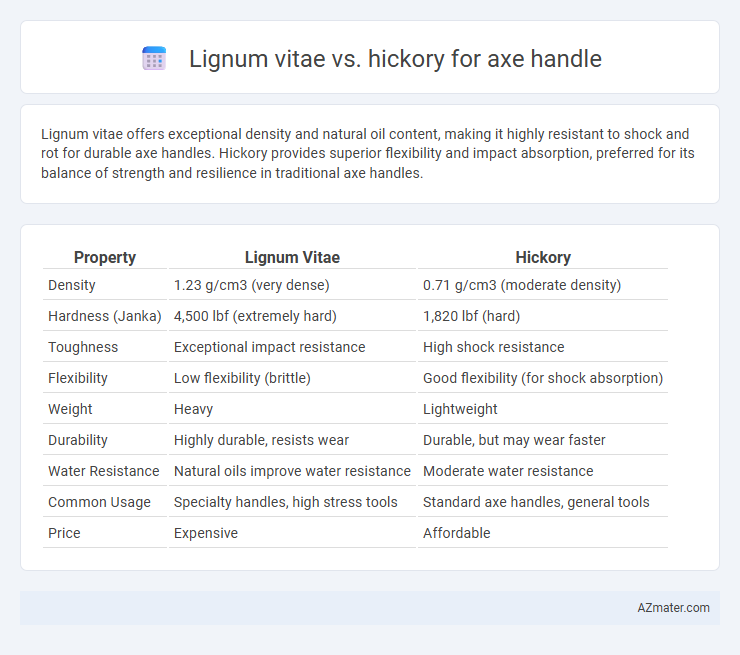Lignum vitae offers exceptional density and natural oil content, making it highly resistant to shock and rot for durable axe handles. Hickory provides superior flexibility and impact absorption, preferred for its balance of strength and resilience in traditional axe handles.
Table of Comparison
| Property | Lignum Vitae | Hickory |
|---|---|---|
| Density | 1.23 g/cm3 (very dense) | 0.71 g/cm3 (moderate density) |
| Hardness (Janka) | 4,500 lbf (extremely hard) | 1,820 lbf (hard) |
| Toughness | Exceptional impact resistance | High shock resistance |
| Flexibility | Low flexibility (brittle) | Good flexibility (for shock absorption) |
| Weight | Heavy | Lightweight |
| Durability | Highly durable, resists wear | Durable, but may wear faster |
| Water Resistance | Natural oils improve water resistance | Moderate water resistance |
| Common Usage | Specialty handles, high stress tools | Standard axe handles, general tools |
| Price | Expensive | Affordable |
Introduction to Lignum Vitae and Hickory for Axe Handles
Lignum vitae, known for its exceptional density and natural oils, offers remarkable durability and resistance to wear, making it a premium choice for axe handles requiring long-lasting strength. Hickory, favored for its superior shock absorption and flexibility, provides a lightweight yet sturdy option that reduces impact strain during intense chopping tasks. Both woods are highly valued in axe handle manufacturing, with lignum vitae excelling in toughness and hickory prized for resilience and comfort.
Historical Use of Lignum Vitae vs Hickory in Toolmaking
Lignum vitae, prized for its exceptional density and natural oils, was historically used in maritime toolmaking and heavy-duty handles where durability and resistance to water were critical, especially in shipbuilding and nautical axes. Hickory became the preferred choice in North American axe handles during the 19th and 20th centuries due to its excellent shock absorption, flexibility, and relatively lightweight nature, making it ideal for forestry and logging tools. The longevity of lignum vitae handles in harsh environments contrasts with hickory's widespread adoption for general-purpose tools, reflecting differing priorities in toolmaking across regions and industries.
Physical Properties: Density and Weight Comparison
Lignum vitae has a higher density, typically around 1.23 g/cm3, making it significantly heavier and denser compared to hickory, which has a density ranging from 0.58 to 0.74 g/cm3. The greater density of lignum vitae contributes to superior durability and resistance to impact, while hickory's lighter weight offers better shock absorption and ease of handling in axe handles. These physical properties influence the choice between lignum vitae and hickory based on the need for strength versus maneuverability in tool performance.
Durability and Shock Absorption Capabilities
Lignum vitae boasts exceptional durability and natural oil content, making it highly resistant to wear and moisture, which enhances longevity in axe handles. Hickory is renowned for its superior shock absorption and flexibility, reducing user fatigue by effectively dampening impact vibrations. Choosing between these woods depends on prioritizing Lignum vitae's toughness or Hickory's ability to absorb shocks for optimal performance.
Resistance to Moisture and Weathering
Lignum vitae outperforms hickory in resistance to moisture and weathering, thanks to its natural oils and high density, which provide exceptional water repellency and durability. Hickory, while tough and shock-resistant, is more prone to absorbing moisture and swelling, requiring frequent maintenance to prevent cracking or warping. For axe handles used in wet or harsh outdoor conditions, lignum vitae offers superior longevity and reduced susceptibility to environmental damage.
Workability and Ease of Carving
Lignum vitae, known for its extreme density and hardness, presents significant challenges in workability and ease of carving, requiring specialized tools and considerable effort to shape effectively. Hickory offers superior workability due to its balanced hardness and toughness, making it much easier to carve and shape with standard woodworking tools. The fiber structure of hickory allows for more precise control during carving, making it the preferred choice for axe handles where ease of customization is important.
Grip Comfort and User Experience
Lignum vitae offers exceptional grip comfort for axe handles due to its natural oil content and dense, smooth texture, which reduces slippage even in wet conditions, enhancing user control and safety. Hickory, while slightly less dense, provides a balanced combination of shock absorption and ergonomic feedback, making it favored for prolonged use and reducing user fatigue. Both woods deliver reliable durability, but Lignum vitae's superior grip and resistance to moisture make it an excellent choice for users prioritizing secure handling and long-lasting comfort.
Availability and Cost Considerations
Lignum vitae, known for its extreme density and durability, is significantly less available and more expensive due to its slow growth and restricted harvesting. Hickory offers widespread availability, making it a cost-effective choice for axe handles with a balance of toughness and flexibility. The price and accessibility of hickory make it the preferred option for most users seeking reliable performance without premium costs.
Environmental Impact and Sustainability
Lignum vitae, known for its extreme density and natural oils, is sourced primarily from slow-growing trees in limited tropical regions, raising concerns about deforestation and habitat loss due to its slow regeneration rate and protected status under CITES. Hickory, native to North America, offers a more sustainable choice as it is widely available, grows rapidly, and is often harvested from managed forests committed to reforestation and ecosystem preservation. Choosing hickory for axe handles supports more sustainable forestry practices with lower environmental impact compared to the ecologically sensitive and legally restricted harvesting of Lignum vitae.
Which Wood is Best: Lignum Vitae or Hickory?
Lignum Vitae, known for its exceptional density and natural oils, offers superior durability and resistance to wear, making it a premium choice for axe handles requiring maximum strength and shock absorption. Hickory, widely favored in North America, balances toughness and flexibility, providing excellent impact resistance and ease of shaping, which contributes to user comfort and long-lasting performance. For applications demanding extreme toughness and natural self-lubrication, Lignum Vitae is best, whereas Hickory excels in versatility and resilience for general-purpose axe handles.

Infographic: Lignum vitae vs Hickory for Axe handle
 azmater.com
azmater.com